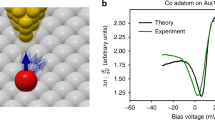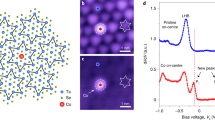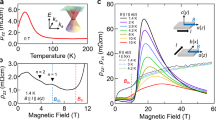Abstract
Cobalt atoms on the (111) surfaces of noble metals are considered to be prototypical systems for the Kondo effect in scanning tunnelling microscopy experiments. Recent first-principles calculations, however, suggest that the experimentally observed spectroscopic zero-bias anomaly can be interpreted in terms of excitations of the spin of the Co atom and the formation of a novel many-body state, namely, the spinaron, rather than from a Kondo resonance. The spinaron is a magnetic polaron that results from the interaction of spin excitations with conduction electrons. However, the experimental confirmation for the existence of spinarons remains elusive. Here we present experimental evidence for spinaronic states in Co atoms on the Cu(111) surface. Our spin-averaged and spin-polarized scanning tunnelling spectroscopy measurements in high magnetic fields allow us to discriminate between the different existing theoretical models and to invalidate the prevailing Kondo-based interpretation of the zero-bias anomaly. Our extended ab initio calculations instead suggest the presence of multiple spinaronic states. Thus, our work provides the foundation to explore the characteristics and consequences of these intriguing hybrid many-body states as well as their design in artificial nanostructures.
This is a preview of subscription content, access via your institution
Access options
Access Nature and 54 other Nature Portfolio journals
Get Nature+, our best-value online-access subscription
$29.99 / 30 days
cancel any time
Subscribe to this journal
Receive 12 print issues and online access
$209.00 per year
only $17.42 per issue
Buy this article
- Purchase on Springer Link
- Instant access to full article PDF
Prices may be subject to local taxes which are calculated during checkout




Similar content being viewed by others
Data availability
The data supporting the findings of this study are available from the corresponding authors upon request. Source data are provided with this paper.
Code availability
The computer code used for data analysis is available from the corresponding authors upon request.
References
Kondo, J. Resistance minimum in dilute magnetic alloys. Progr. Theor. Phys. 32, 37–49 (1964).
Abrikosov, A. A. Electron scattering on magnetic impurities in metals and anomalous resistivity effects. Phys. Phys. Fiz. 2, 5 (1965).
Suhl, H. Dispersion theory of the Kondo effect. Phys. Rev. 138, A515 (1965).
Ternes, M., Heinrich, A. J. & Schneider, W.-D. Spectroscopic manifestations of the Kondo effect on single adatoms. J. Phys.: Condens. Matter 21, 053001 (2009).
Li, J., Schneider, W.-D., Berndt, R. & Delley, B. Kondo scattering observed at a single magnetic impurity. Phys. Rev. Lett. 80, 2893 (1998).
Madhavan, V., Chen, W., Jamneala, T., Crommie, M. F. & Wingreen, N. S. Tunneling into a single magnetic atom: spectroscopic evidence of the Kondo resonance. Science 280, 567–569 (1998).
Manoharan, H. C., Lutz, C. P. & Eigler, D. M. Quantum mirages formed by coherent projection of electronic structure. Nature 403, 512–515 (2000).
Knorr, N., Schneider, M. A., Diekhöner, L., Wahl, P. & Kern, K. Kondo effect of single Co adatoms on Cu surfaces. Phys. Rev. Lett. 88, 096804 (2002).
Schneider, M. A., Vitali, L., Knorr, N. & Kern, K. Observing the scattering phase shift of isolated Kondo impurities at surfaces. Phys. Rev. B 65, 121406 (2002).
Pivetta, M., Ternes, M., Patthey, F. & Schneider, W.-D. Diatomic molecular switches to enable the observation of very-low-energy vibrations. Phys. Rev. Lett. 99, 126104 (2007).
Fano, U. Effects of configuration interaction on intensities and phase shifts. Phys. Rev. 124, 1866 (1961).
Fernández, J., Roura-Bas, P. & Aligia, A. A. Theory of differential conductance of Co on Cu(111) including Co s and d orbitals, and surface and bulk Cu states. Phys. Rev. Lett. 126, 046801 (2021).
Tacca, M. S., Jacob, T. & Goldberg, E. C. Influence of surface states on the conductance spectra for Co adsorbed on Cu(111). Phys. Rev. B 103, 245419 (2021).
Schweflinghaus, B., dos Santos Dias, M., Costa, A. T. & Lounis, S. Renormalization of electron self-energies via their interaction with spin excitations: a first-principles investigation. Phys. Rev. B 89, 235439 (2014).
Bouaziz, J., Mendes Guimarãres, F. S. & Lounis, S. A new view on the origin of zero-bias anomalies of Co atoms atop noble metal surfaces. Nat. Commun. 11, 6112 (2020).
Edwards, D. M. & Hertz, J. A. Electron-magnon interactions in itinerant ferromagnetism. II. Strong ferromagnetism. J. Phys. F: Met. Phys. 3, 2191 (1973).
Barral, M. A., Llois, A. M. & Aligia, A. A. Hybridization of impurity states with the Shockley surface band versus bulk states. Phys. Rev. B 70, 035416 (2004).
Lin, C.-Y., Castro Neto, A. H. & Jones, B. A. First-principles calculation of the single impurity surface Kondo resonance. Phys. Rev. Lett. 97, 156102 (2006).
Henzl, J. & Morgenstern, K. Contribution of the surface state to the observation of the surface Kondo resonance. Phys. Rev. Lett. 98, 266601 (2007).
Baruselli, P. P., Requist, R., Smogunov, A., Fabrizio, M. & Tosatti, E. Co adatoms on Cu surfaces: ballistic conductance and Kondo temperature. Phys. Rev. Lett. 92, 045119 (2015).
Li, Q. L. et al. Role of the surface state in the Kondo resonance width of a Co single adatom on Ag(111). Phys. Rev. B 97, 035417 (2018).
Moro-Lagares, M. et al. Quantifying the leading role of the surface state in the Kondo effect of Co/Ag(111). Phys. Rev. B 97, 235442 (2018).
Madhavan, V., Chen, W., Jamneala, T., Crommie, M. F. & Wingreen, N. S. Local spectroscopy of a Kondo impurity: Co on Au(111). Phys. Rev. B 64, 165412 (2001).
Néel, N. et al. Controlling the Kondo effect in CoCun clusters atom by atom. Phys. Rev. Lett. 101, 266803 (2008).
Kawahara, S. L. et al. Kondo peak splitting on a single adatom coupled to a magnetic cluster. Phys. Rev. B 82, 020406 (2010).
Choi, D.-J. et al. Kondo resonance of a Co atom exchange coupled to a ferromagnetic tip. Nano Lett. 16, 6298–6302 (2016).
Néel, N. et al. Single-Co Kondo effect in atomic Cu wires on Cu(111). Phys. Rev. Res. 2, 023309 (2020).
Shick, A. B., Tchaplianka, M. & Lichtenstein, A. I. Spin- orbit coupling and Kondo resonance in the Co adatom on the Cu(100) surface: DFT plus exact diagonalization study. Phys. Rev. B 106, 245115 (2022).
Hänke, T., Bode, M., Krause, S., Berbil-Bautista, L. & Wiesendanger, R. Temperature-dependent scanning tunneling spectroscopy of Cr(001): orbital Kondo resonance versus surface state. Phys. Rev. B 72, 085453 (2005).
Otte, A. F. et al. The role of magnetic anisotropy in the Kondo effect. Nat. Phys. 4, 847–850 (2008).
Knorr, N. et al. Long-range adsorbate interactions mediated by a two-dimensional electron gas. Phys. Rev. B 65, 115420 (2002).
Patton, K. R., Kettemann, S., Zhuravlev, A. & Lichtenstein, A. Spin-polarized tunneling microscopy and the Kondo effect. Phys. Rev. B 76, 100408 (2007).
Seridonio, A. C., Souza, F. M. & Shelykh, I. A. Spin-polarized STM for a Kondo adatom. J. Phys.: Condens. Matter 21, 095003 (2009).
von Bergmann, K., Ternes, M., Loth, S., Lutz, C. P. & Heinrich, A. J. Spin polarization of the split Kondo state. Phys. Rev. Lett. 114, 076601 (2015).
Loth, S. et al. Controlling the state of quantum spins with electric currents. Nat. Phys. 6, 340–344 (2010).
Loth, S., Lutz, C. P. & Heinrich, A. J. Spin-polarized spin excitation spectroscopy. New J. Phys. 12, 125021 (2010).
Brinker, S., Küster, F., Parkin, S. S. P., Sessi, P. & Lounis, S. Anomalous excitations of atomically crafted quantum magnets. Sci. Adv. 8, eabi7291 (2022).
Hirjibehedin, C. F. et al. Large magnetic anisotropy of a single atomic spin embedded in a surface molecular network. Science 317, 1199–1203 (2007).
Cui, J., White, J. D. & Diehl, R. D. Anomalous inelastic He-atom scattering intensities for the vibrational modes of alkali metals on graphite. Surf. Sci. Lett. 293, L841–L846 (1993).
Ormaza, M. et al. Controlled spin switching in a metallocene molecular junction. Nat. Commun. 8, 1974 (2017).
Verlhac, B. et al. Atomic-scale spin sensing with a single molecule at the apex of a scanning tunneling microscope. Science 366, 623–627 (2019).
Brodde, A., Dreps, K., Binder, J., Lunau, C. & Neddermeyer, H. Scanning tunneling microscopy and photoemission from Fe/Cu(111). Phys. Rev. B 47, 6609 (1993).
Ternes, M. Spin excitations and correlations in scanning tunneling spectroscopy. New J. Phys. 17, 063016 (2015).
Tersoff, J. & Hamann, D. R. Theory and application for the scanning tunneling microscope. Phys. Rev. Lett. 50, 1998 (1983).
Néel, N., Kröger, J. & Berndt, R. Kondo effect of a Co atom on Cu(111) in contact with an iron tip. Phys. Rev. B 7, 233401 (2010).
Bork, J. et al. A tunable two-impurity Kondo system in an atomic point contact. Phys. Rev. B 82, 233401 (2010).
Chen, W., Jamneala, T., Madhavan, V. & Crommie, M. F. Disappearance of the Kondo resonance for atomically fabricated cobalt dimers. Phys. Rev. B 60, R8529 (1999).
Noei, N. et al. Manipulating the spin orientation of Co Atoms using monatomic Cu chains. Nano Lett. 23, 8988–8994 (2023).
Bauer, D. S. G. Development of a relativistic full-potential first-principles multiple scattering Green function method applied to complex magnetic textures of nano structures at surfaces. Forschungszentrum Jülich (2014).
Lounis, S., Costa, A. T., Muniz, R. B. & Mills, D. L. Dynamical magnetic excitations of nanostructures from first principles. Phys. Rev. Lett. 105, 187205 (2010).
Lounis, S., Costa, A. T., Muniz, R. B. & Mills, D. L. Theory of local dynamical magnetic susceptibilities from the Korringa-Kohn-Rostoker Green function method. Phys. Rev. B 83, 035109 (2011).
dos Santos Dias, M., Schweflinghaus, B., Blügel, S. & Lounis, S. Relativistic dynamical spin excitations of magnetic adatoms. Phys. Rev. B 91, 075405 (2015).
Bouaziz, J., Mendes Guimarães, F. S. & Lounis, S. A new view on the origin of zero-bias anomalies of Co atoms atop noble metal surfaces. Nat. Commun. 11, 6112 (2020).
Acknowledgements
This research was supported by the DFG through SFB 1170 ‘ToCoTronics’ and the Würzburg-Dresden Cluster of Excellence ct.qmat, EXC2147, via project ID 390858490. M.B., A.O. and F.F. thank P. Sessi (Max-Planck-Institut für Mikrostrukturphysik, Halle, Germany) for bringing this scientific topic to our attention. J.B. acknowledges support by the European Research Council (ERC) under the European Union’s Horizon 2020 research and innovation programme (grant no. 856538, project ‘3D MAGiC’). S.L. acknowledges S. Brinker and A. Weismann for fruitful discussions.
Author information
Authors and Affiliations
Contributions
F.F., A.O., M.B. and S.L. conceived the experiments. F.F. and A.O. conducted the measurements and analysed the data. J.B. performed the first-principles simulations. S.L. and M.B. supervised the project. All authors discussed the results. F.F. and S.L. wrote the manuscript with input from all authors.
Corresponding authors
Ethics declarations
Competing interests
The authors declare no competing interests.
Peer review
Peer review information
Nature Physics thanks Jörg Kröger and the other, anonymous, reviewer(s) for their contribution to the peer review of this work.
Additional information
Publisher’s note Springer Nature remains neutral with regard to jurisdictional claims in published maps and institutional affiliations.
Supplementary information
Supplementary Information
Supplementary Figs. 1–7 and discussion.
Source data
Source Data Fig. 1
Data points used for the schematic of the field-induced splitting of magnetic resonances and excitations.
Source Data Fig. 2a
STM data of the Cu(111) surface with single adsorbed Co atoms (Fig. 2a).
Source Data Fig. 2
Unprocessed experimental data of magnetic-field-dependent splitting of the ZBA (Fig. 2b–h).
Source Data Fig. 3a
STM data of the Cu(111) surface decorated with Fe islands, Nc molecules and Co atoms.
Source Data Fig. 3
Unprocessed experimental data and fits of spin-resolved measurements on Co/Cu(111).
Source Data Fig. 4
Calculated orbital-resolved LDOS and theoretical inelastic tunnelling spectra.
Rights and permissions
Springer Nature or its licensor (e.g. a society or other partner) holds exclusive rights to this article under a publishing agreement with the author(s) or other rightsholder(s); author self-archiving of the accepted manuscript version of this article is solely governed by the terms of such publishing agreement and applicable law.
About this article
Cite this article
Friedrich, F., Odobesko, A., Bouaziz, J. et al. Evidence for spinarons in Co adatoms. Nat. Phys. 20, 28–33 (2024). https://doi.org/10.1038/s41567-023-02262-6
Received:
Accepted:
Published:
Issue Date:
DOI: https://doi.org/10.1038/s41567-023-02262-6



